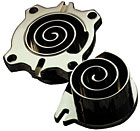
“This has been an industry that has not changed rapidly,” assured Ed Purvis, Emerson group vice president of Emerson Climate Technologies Refrigeration. “I mean it’s a fairly cautious industry. People think things through, and then they step slowly.”
It’s why he, along with everyone within Emerson Climate Technologies associated with the Copeland Scroll® brand, is proud of the fact that today scroll compressors are used in over two-thirds of all products that achieve the U.S. industry standard 13 SEER (Seasonal Energy Efficiency Ratio) efficiency. And to think that it was only 20 years ago that Emerson Climate Technologies, Inc., then known as Copeland Corporation, introduced and began producing its then-new Copeland Scroll compressor at its facility in Sidney, Ohio. At that time in 1987, 100 percent of the industry was using reciprocating compressors in 8 SEER systems.
“We were confident in our technology, but we were all still pleasantly surprised by just how quickly the industry embraced scroll as a clearly superior technology,” said Purvis. “I’m not sure that’s happened in this industry before.”
You could call it a “leap of faith” on the industry’s part. In truth, though, there are more than a few solid reasons that Copeland Scroll took the industry by storm. Not only was it a revolutionary leap in technology for the entire industry, it also provided an answer to achieving greater – and government-required – energy efficiencies. The Copeland Scroll compressor received two national awards in 1988, and Popular Science also selected the technology for one of its “Best of What’s New” grand awards.
Emerson would rather refer to this rapid transformation from reciprocating to scroll technology as “the birth of high efficiency for the cooling industry.”

Bob Novello, Matt Diggs and Dean Ruwe cut ribbon in 1987 to
open the first scroll production plant in North America. (Click on the image
for an enlarged view.)
RISKS, COUNTLESS TESTING, AND MUCH MORE
The truth be known, Copeland Scroll was a big risk that Emerson was willing to take. In the end, the countless hours of design and product testing – not to mention a nice chunk of capital investment – paid off, for Emerson and for the industry as a whole.“The development of Copeland Scroll is very much a child of our business strategy,” said Matt Diggs, former president of Copeland Corporation, 1975–1981. “The strategy was driven by two things. One was a domestic need for energy efficiency that our customers – and we – were feeling; and the other reason, which was equally important, was the globalization of the industry.”
On October 12, 1986, Copeland was acquired by Emerson Electric Co. of St. Louis. Company officials will tell you that the merger provided exceptional synergistic benefits for both.
“The whole scroll program was a risky program,” admitted Robert J. Novello, an executive vice president at Emerson who became chairman of the board and chief executive officer of Copeland in the fall of 1987. “There were three things that bothered us. The first was reliability. There had been two companies that came out with rotary compressors. One was Japanese and one was American. The Japanese company lost half-a-billion dollars on this rotating technology, while the American company lost close to a billion dollars. So, it was of utmost importance to us that our product met very strict, self-imposed reliability standards before we took it to market.”
Another obstacle: A factory had to be built, but it was projected to cost $100 million - and this was after Emerson had spent tens of millions of dollars on research and development on Copeland Scroll.
“If this product came out and just shut down our Hartselle, Alabama, reciprocating compressor plant, there was no way the economics would work,” assured Novello. “We had to come up with a strategy to make sure the new scroll products provided incremental sales growth and would not just replace our existing base of reciprocating compressors – and we did that.”
“And the third thing was efficiency,” he added. “We had to find ways to keep achieving higher and higher levels of efficiency because that was what was going to sell this product.”
Bottom line: The company’s reputation in the field of application engineering and resources proved vital. Because reliability was a chief concern, providing reliability was factored into each step of the research and development (R&D) and the production process in order to make certain that Copeland Scroll would work in rugged, real-world applications.
GAME CHANGER AND REVOLUTIONIZER
When Copeland Scroll first came off the assembly line, the market was entirely reciprocating. That all changed, however, when the industry found out that scroll addressed energy concerns; this at a time when proponents for new standards in efficiency (10 SEER) were clamoring for a breakthrough product. As company officials will tell you, Copeland saw this as an opportunity to help the industry through the ever-pressing efficiency regulations by developing a new technology that not only met the needs of efficiency, but also improved sound and reliability.“The impact of the scroll really cannot be overstated,” commented Dean Ruwe, who joined Copeland in 1981 as vice president of operations and was also president and chief operating officer (1997-2003). “It came at a time when government-mandated regulations were a high priority for this industry.”
The Copeland Scroll compressor continues to be at the heart of energy issues, revolutionizing this industry.
Publication date:11/12/2007

Report Abusive Comment